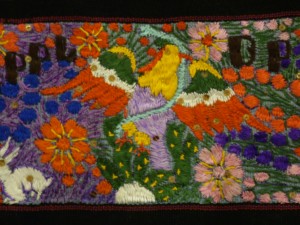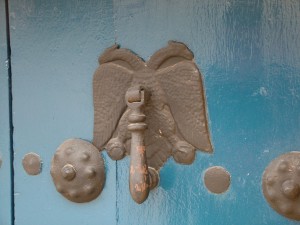The eagle is ubiquitous across Mesoamerican art and across time. We are assembling here resources for a study of this important bird and its ethnobiological significance.
- Mexicolore’s “The Eagle” (Renee McGarry) takes a brief but temporally longitudinal and cross-cultural look at the significance of the eagle in Mexican culture.
- Wikipedia article, “Eagle Warrior“
- The Habsburg two-headed eagle is a prominent motif in colonial art, but a two-headed eagle or bird was also known in pre-Columbian art, such as one can find in Maya stamp art

Eagle costume (left) on the male of the ruling couple, detail from a lienzo of Tequixtepec (Photo, R. Haskett, 2011)

A Franciscan coat of arms carved in stone by indigenous artists in the sixteenth century for a new church that was built on the site of a temple dedicated to the Nahua god, Huitzilopochtli, identified with the sun and the eagle, in what is now Mexico City. Museum in the Santo Domingo Cultural Center. (R. Haskett, 2011)

Detail from a mural featuring an eagle, from an exhibition in the Santo Domingo Cultural Center (S. Wood, July 2011)

The eagle on the cactus devouring a serpent is a quintessentially Mexican symbol, ubiquitous in Mexican art across the ages and present on the modern Mexican flag. Museo Textil, Oaxaca. (S. Wood, 2010)
For a close study (in Spanish) of the “águila bicéfala” with an emphasis on the state of Oaxaca, see this article by Juan de Dios Gómez Ramírez, published in Ecochac in 2012.



